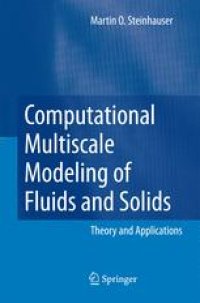
Ebook: Computational Multiscale Modeling of Fluids and Solids: Theory and Applications
- Tags: Mathematical and Computational Physics, Mathematical Methods in Physics, Mechanics Fluids Thermodynamics, Physical Chemistry, Physics and Applied Physics in Engineering
- Year: 2008
- Publisher: Springer-Verlag Berlin Heidelberg
- Edition: 1
- Language: English
- pdf
The idea of the book is to provide a comprehensive overview of computational physics methods and techniques, that are used for materials modeling on different length and time scales. Each chapter first provides an overview of the physical basic principles which are the basis for the numerical and mathematical modeling on the respective length-scale.
The book includes the micro-scale, the meso-scale and the macro-scale. The chapters follow this classification. The book will explain in detail many tricks of the trade of some of the most important methods and techniques that are used to simulate materials on the perspective levels of spatial and temporal resolution. Case studies are occasionally included to further illustrate some methods or theoretical considerations. Example applications for all techniques are provided, some of which are from the author’s own contributions to some of the research areas. Methods are explained, if possible, on the basis of the original publications but also references to standard text books established in the various fields are mentioned.
The idea of the book is to provide a comprehensive overview of computational physics methods and techniques, that are used for materials modeling on different length and time scales. Each chapter first provides an overview of the physical basic principles which are the basis for the numerical and mathematical modeling on the respective length-scale.
The book includes the micro-scale, the meso-scale and the macro-scale. The chapters follow this classification. The book will explain in detail many tricks of the trade of some of the most important methods and techniques that are used to simulate materials on the perspective levels of spatial and temporal resolution. Case studies are occasionally included to further illustrate some methods or theoretical considerations. Example applications for all techniques are provided, some of which are from the author’s own contributions to some of the research areas. Methods are explained, if possible, on the basis of the original publications but also references to standard text books established in the various fields are mentioned.
The idea of the book is to provide a comprehensive overview of computational physics methods and techniques, that are used for materials modeling on different length and time scales. Each chapter first provides an overview of the physical basic principles which are the basis for the numerical and mathematical modeling on the respective length-scale.
The book includes the micro-scale, the meso-scale and the macro-scale. The chapters follow this classification. The book will explain in detail many tricks of the trade of some of the most important methods and techniques that are used to simulate materials on the perspective levels of spatial and temporal resolution. Case studies are occasionally included to further illustrate some methods or theoretical considerations. Example applications for all techniques are provided, some of which are from the author’s own contributions to some of the research areas. Methods are explained, if possible, on the basis of the original publications but also references to standard text books established in the various fields are mentioned.
Content:
Front Matter....Pages I-XVII
Front Matter....Pages 1-1
Introduction....Pages 3-26
Multiscale Computational Materials Science....Pages 27-107
Mathematical and Physical Prerequisites....Pages 109-177
Fundamentals of Numerical Simulation....Pages 179-217
Front Matter....Pages 219-223
Computational Methods on Electronic/Atomistic Scale....Pages 225-267
Computational Methods on Atomistic/Microscopic Scale....Pages 269-327
Computational Methods on Mesoscopic/Macroscopic Scale....Pages 329-376
Perspectives in Multiscale Materials Modeling....Pages 377-379
Back Matter....Pages 381-427
The idea of the book is to provide a comprehensive overview of computational physics methods and techniques, that are used for materials modeling on different length and time scales. Each chapter first provides an overview of the physical basic principles which are the basis for the numerical and mathematical modeling on the respective length-scale.
The book includes the micro-scale, the meso-scale and the macro-scale. The chapters follow this classification. The book will explain in detail many tricks of the trade of some of the most important methods and techniques that are used to simulate materials on the perspective levels of spatial and temporal resolution. Case studies are occasionally included to further illustrate some methods or theoretical considerations. Example applications for all techniques are provided, some of which are from the author’s own contributions to some of the research areas. Methods are explained, if possible, on the basis of the original publications but also references to standard text books established in the various fields are mentioned.
Content:
Front Matter....Pages I-XVII
Front Matter....Pages 1-1
Introduction....Pages 3-26
Multiscale Computational Materials Science....Pages 27-107
Mathematical and Physical Prerequisites....Pages 109-177
Fundamentals of Numerical Simulation....Pages 179-217
Front Matter....Pages 219-223
Computational Methods on Electronic/Atomistic Scale....Pages 225-267
Computational Methods on Atomistic/Microscopic Scale....Pages 269-327
Computational Methods on Mesoscopic/Macroscopic Scale....Pages 329-376
Perspectives in Multiscale Materials Modeling....Pages 377-379
Back Matter....Pages 381-427
....